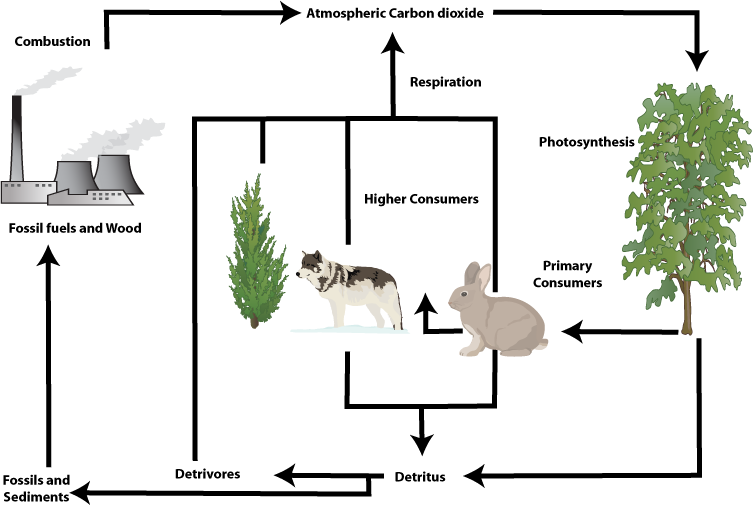2.5. 4: Transfers and Transformations - Global Cycles
The biogeochemical cycles.
Movement of nutrients and energy through the ecosystem is quite different.
Energy travels from the sun, through food webs and is eventual lost to space as heat.
Nutrients are recycled and reused. (Via the decomposer food chain)
Organisms die and are decomposed
Nutrients are released
Eventually become parts of living things again, when they are taken up by plants
These are the BIOGEOCHEMICAL CYCLES
The balance between Photosynthesis, Respiration and incorporation into the lithosphere
Carbon is an essential element in living systems, providing the chemical framework to form molecules that make up living organisms. Carbon makes up around 0.03% of the atmosphere as carbon dioxide, and is present in the Oceans as carbonate and bicarbonates and in rocks such as limestone and coal.
Carbon cycles between living (biotic) and non-living (abiotic) chemical cycles: carbon is fixed by photosynthesis and released back to the atmosphere through respiration. Carbon is also released back to the atmosphere through combustion, including fossil fuels and biomass.
 Carbon can remain locked in either cycle for long periods of time. ie in the wood of trees or as coal and oil.
Carbon can remain locked in either cycle for long periods of time. ie in the wood of trees or as coal and oil.
Human activity has disrupted the balance of the global carbon cycle (carbon budget) through increased combustion, land use changes and deforestation.
CLICK ON THE THUMBNAIL ON THE LEFT TO SEE A SYSTEM DIAGRAM OF THE CARBON CYCLE
Nitrogen cycle
Understanding the Nitrogen Cycle from Sciencebitz com on Vimeo.
All living organisms use nitrogen to make molecules such as protein and DNA. Nitrogen is the most abundant gas in the atmosphere but atmospheric nitrogen is unavailable to plants and animals, though some specialized micro-organisms can fix atmospheric nitrogen. The nitrogen cycle can be thought of in three basic stages.
 Nitrogen fixation: atmospheric nitrogen is made available to plants through the fixation of atmospheric nitrogen as ammonia by nitrogen fixing bacteria either free living in the soil (Azotobacter) or symbiotically in root nodules (Rhizobium). lightening also causes the oxidation of nitrogen gas to nitrate which is washed into the soil.
Nitrogen fixation: atmospheric nitrogen is made available to plants through the fixation of atmospheric nitrogen as ammonia by nitrogen fixing bacteria either free living in the soil (Azotobacter) or symbiotically in root nodules (Rhizobium). lightening also causes the oxidation of nitrogen gas to nitrate which is washed into the soil.
Denitrification: denitrifying bacteria (Pseudomonas denitrificans)in waterlogged and anearobic conditions reverse this process converting ammonia, nitrate and nitrite to nitrogen gas which escapes to the atmosphere.
Nitrification: some nitrifying bacteria are able to convert ammonium to nitrites (Nitrosomonas) while other convert the nitrites to nitrates (Nitrobacter) which is then available to be absorbed by roots.
Humans have intervened in the nitrogen cycle by applying large amounts of nitrogen fertilisers to the land, either as organic sources (manure and green crops) or as inorganic chemical fertilisers. overuse of fertilisers can lead to serious pollution problems particularly to water supplies. (Eutrophication)
The Hydrological cycle
 The hydrological or water cycle involves the transfer of water between atmosphere rivers lakes and oceans and the lithosphere. To move between these different sections water molecules often need to be transformed from one phase to another. E.g. Liquid water evaporates from surfaces allowing transfer to the atmosphere as gas where it condenses out in clouds to fall as liquid precipitation again.
The hydrological or water cycle involves the transfer of water between atmosphere rivers lakes and oceans and the lithosphere. To move between these different sections water molecules often need to be transformed from one phase to another. E.g. Liquid water evaporates from surfaces allowing transfer to the atmosphere as gas where it condenses out in clouds to fall as liquid precipitation again.
It is easy to think about Lakes, Oceans and Ground water as stores (sinks), but the largest store of fresh water is held within snow and ice. The polar ice caps and mountain glaciers in particular are an enormous sinks of water temporarily removed from the cycle ( though this could be for thousands of years) and unavailable for use by organisms.
As well as being essential for life it is the water cycle that drives the worlds weather systems.
